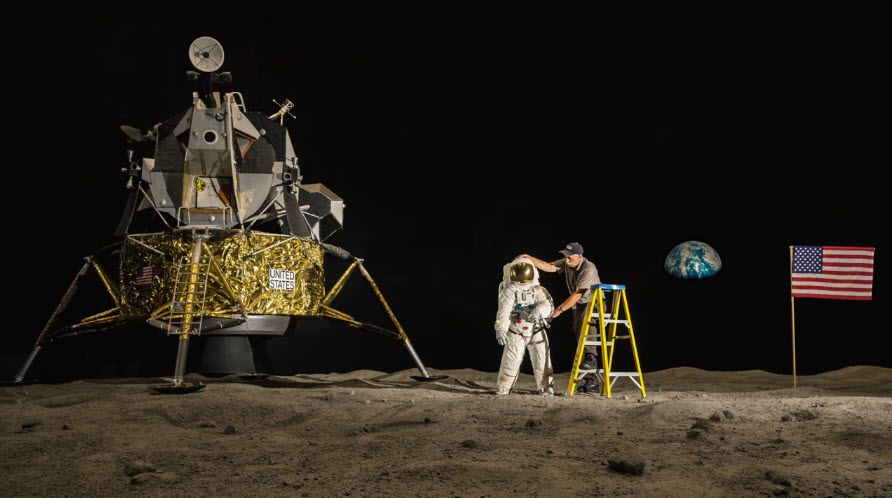대구외고 2학년 기말고사 대비(The Age of Disbelief)-(2)
대한민국 1% 영어강사, 찍신 이상엽 쌤은 내신과 수능에 최적화된 실전문제를 제공합니다. 이상엽 쌤은 대구외고 수험생들을 위해 선생님들의 출제경향을 정확히 분석해 맞춤예상 문제를 제공합니다. 본 문제에 대한 궁금한 점 또는 영어가 어렵고 고민이면, 010-2818-6994로 연락주세요.
Making Sense of the World
[12~19] 다음 글을 읽고, 물음에 답하시오.
[F] The trouble goes way back, of course. The scientific method has led us to truths that are less than self-evident, often mind-blowing, and sometimes hard to accept. For example, both the sun and moon appear to cross the sky above the Earth, but while the moon does indeed circle our world, the Earth circles the sun. Although the roundness of the Earth has been known for thousands of years, alternative geographies persisted even after trips around the world had become common. Nineteenth-century flat-Earthers, for example, believed that the planet was centered on the North Pole and bounded by a wall of ice, with the sun and moon traveling only a few hundred kilometers about the Earth.
[G] Even when we intellectually accept the precepts of science, we cling to our intuitions—what researchers call our naive beliefs. As we become scientifically literate, we (A) our naive beliefs, but never eliminate them entirely. They remain hidden in our brains as we try to make sense of the world.
[H] Most of us do that by relying on personal experience, anecdotes, or stories rather than statistics. If we hear about a cluster of cancer cases in a town with a hazardous waste dump, we assume pollution caused the cancers. Yet just because two things happened together doesn’t mean one caused the other, and just because events are clustered doesn’t mean they’re not still random.
[I] We have trouble comprehending randomness; our brains (B) pattern and meaning. Science warns us, however, that we can deceive ourselves. To be confident there’s a causal connection between the dump and the cancers, you need statistical analysis showing that there are many more cancers than would be expected randomly, evidence that the victims were exposed to chemicals from the dump, and evidence that the chemicals really can cause cancer.
[J] Even for scientists, the scientific method is a hard discipline. Like the rest of us, they’re vulnerable to confirmation bias—the tendency to look for and see only evidence that confirms what they already believe. But unlike the rest of us, they submit their ideas to formal peer review before publishing them. Once their results are published, other scientists will try to reproduce them—and, being skeptical and competitive, will be very happy to announce that they don’t hold up.
12. 윗글의 제목으로 가장 적절한 것은?
① Why Our Brains Struggle to Accept Scientific Truths
② The Sun, the Moon, and Flat-Earth Stories
③ Personal Experience Versus Statistics in Daily Life
13. Which of the following words is closest in meaning to the word “mind-blowing” in paragraph F?
① astonishing ② disputable ③ confusing ④ traditional
14. What does the author imply about “naive beliefs”?
① Naive beliefs are completely eliminated once we become scientifically literate.
② Naive beliefs are only held by people who are not scientists.
③ Naive beliefs persist even after we learn scientific concepts and can influence our thinking.
④ Naive beliefs are always correct and should be trusted over scientific evidence.
15. What is the purpose of paragraph H?
a. To explain how scientific discoveries have changed our understanding of the world
b. To describe the process of peer review in scientific research
c. To discuss the persistence of naive beliefs in the human mind
d. To illustrate how people often rely on personal stories rather than scientific evidence
16. What is the purpose of paragraph I?
a. To describe how scientists conduct experiments
b. To illustrate why people believe in conspiracy theories
c. To explain why personal experience can be misleading without scientific analysis
d. To show that scientific facts are always easy to understand
17. 윗글의 빈칸 (A), (B)에 들어갈 말로 가장 적절한 것을 고르시오.
(A) (B)
① create …… seek
② suppress …… amplify
③ forget …… dismiss
④ repress …… crave
⑤ reject …… avoid
18. What type of figurative language is used in the following sentence from the passage?
If we hear about a cluster of cancer cases in a town with a hazardous waste dump, we assume pollution caused the cancers. |
a. personification
b. hyperbole
c. anecdote
d. alliteration
19. 윗글에 대한 설명이나 추론으로 가장 적절하지 않은 것은?
① People often rely on intuition and personal stories rather than scientific evidence when interpreting events around them.
② Even scientists can fall prey to confirmation bias, but their work is checked through peer review and replication.
③ Scientific truths can be counterintuitive, and naive beliefs can persist even after learning the scientific explanation.
④ Random patterns are hard for our brains to accept, so we often see connections where none exist.
⑤ The scientific method always guarantees that all published results are completely accurate and never challenged.
[해석]
[F] 물론 이 문제는 오래 전부터 시작되었습니다. 과학적 방법은 우리에게 자명하지 않은 진리들, 때로는 충격적이고 받아들이기 어려운 사실들을 밝혀냈습니다. 예를 들어, 태양과 달은 하늘을 가로질러 지구 위를 움직이는 것처럼 보이지만, 실제로는 달만이 지구 주위를 돌고, 지구는 태양 주위를 돕니다. 지구가 둥글다는 사실은 수천 년 전부터 알려져 있었지만, 세계 일주가 흔한 일이 된 이후에도 다른 형태의 지리관이 여전히 존재했습니다. 예를 들어, 19세기의 평평한 지구를 믿는 사람들은 지구가 북극을 중심으로 하며, 얼음 벽으로 둘러싸여 있고, 태양과 달은 지구 위 몇 백 킬로미터만을 이동한다고 믿었습니다.
[G] 우리는 과학의 전제를 지적으로 받아들일 때조차, 직관에 의존하는 경향이 있습니다. 연구자들은 이것을 ‘순진한 믿음(naive beliefs)’이라고 부릅니다. 과학적 소양이 높아지면서 우리는 이러한 순진한 믿음을 억제하지만, 완전히 없애지는 못합니다. 그 믿음은 여전히 뇌 속 어딘가에 숨어 있으며, 우리는 세상을 이해하려 할 때 그것에 의지하게 됩니다.
[H] 대부분의 사람들은 통계보다는 개인적인 경험, 일화, 이야기 등에 의존해 세상을 이해하려 합니다. 예를 들어, 어떤 마을에 유해 폐기물 처리장이 있고 암 환자가 많이 발생했다는 이야기를 들으면, 우리는 본능적으로 오염이 암의 원인이라고 추정합니다. 하지만 두 사건이 동시에 일어났다고 해서 하나가 다른 하나를 일으켰다는 의미는 아니며, 사건들이 모여 있다고 해서 그것이 무작위적이지 않다는 뜻도 아닙니다.
[I] 우리는 무작위성을 이해하는 데 어려움을 겪습니다. 우리의 뇌는 패턴과 의미를 갈망합니다. 그러나 과학은 우리가 스스로를 속일 수 있다는 사실을 경고합니다. 폐기물 처리장과 암 사이에 인과관계가 있다고 자신 있게 말하려면, 무작위로 기대되는 수치보다 훨씬 많은 암 사례가 있다는 통계적 분석, 피해자들이 실제로 그 폐기물에 노출되었다는 증거, 그리고 그 폐기물의 화학 물질이 실제로 암을 유발할 수 있다는 증거가 필요합니다.
[J] 과학자들에게조차 과학적 방법은 엄격한 훈련입니다. 그들 또한 우리처럼 확증 편향—즉 자신이 이미 믿고 있는 것을 확인시켜주는 증거만을 찾고 보는 경향—에 취약합니다. 그러나 일반인과 달리, 그들은 자신의 연구 결과를 발표하기 전에 공식적인 동료 평가(peer review)를 거칩니다. 연구 결과가 발표되면 다른 과학자들이 그것을 재현하려고 시도하며, 회의적이고 경쟁적인 그들은 결과가 재현되지 않는다는 사실을 기꺼이 밝히려 합니다.
정답 및 해설
12. ①
해설: 증거가 충분하더라도 과학적 사실을 받아들이는 데 있어 인간이 직면하는 심리적, 인지적 어려움을 논의하고 있다. 이 글은 우리의 직관, 편견, 그리고 일화에 대한 의존이 과학적 연구에 어떻게 방해가 되는지에 대해 논의한다.
13. ①
14. ③
해설: [G] 단락에서 저자는 “과학 지식이 풍부해짐에 따라 우리는 순진한 믿음을 억누르지만, 결코 완전히 없애지는 못한다. 세상을 이해하려고 노력하는 동안 우리의 뇌 속에 숨겨진 믿음은 그대로 남아 있다.”라고 말한다. 이는 우리가 지적으로 과학적 아이디어를 수용하더라도, 직관적이고 “순진한” 믿음은 여전히 우리 마음속에 존재하며 세상을 해석하는 방식에 영향을 미칠 수 있음을 의미한다.
15. d
해설: [H] 단락은 대부분의 사람들이 통계나 과학적 증거에 의존하기보다는 개인적인 경험, 일화 또는 이야기를 통해 세상을 이해한다는 생각에 초점을 맞춘다. 통계적 증거의 필요성은 고려하지 않고, 단지 오염이 암 집단을 유발한다고 가정하는 사람들의 사례를 제시한다. 이는 과학적 분석보다 일화적 증거를 선호하는 경향을 보여주는데, 이것이 바로 이 단락의 핵심이다.
16. c
해설 [I] 단락은 사람들이 무작위성을 이해하는 데 어려움을 겪고, 패턴과 의미가 존재하지 않는 경우에도 패턴과 의미를 파악하는 경향이 있다는 점을 논한다. 이어서 과학에 따르면, 일화적인 증거에 기반하여 인과 관계를 가정함으로써 우리는 쉽게 스스로를 속일 수 있다고 설명한다. 이 단락은 오염과 암 사이의 인과 관계를 확실하게 확립하기 위해서는 개인적인 경험이나 관찰된 집단뿐만 아니라 엄격한 통계 분석과 과학적 증거가 필요하다는 점을 강조한다.
17. ④
해설: (A) 문맥상 우리가 과학 지식이 더 풍부해지더라도 순진한 믿음을 완전히 없애지는 못한다는 것을 보여준다. 그것들은 “우리 뇌 속에 숨겨져” 있다. “억제하다”라는 단어는 무언가를 제거하지 않고 억누르거나 통제하는 것을 의미하므로 적절하다. (B) 우리의 뇌가 무작위적인 사건에서도 패턴과 의미를 찾으려고 노력하는 방식을 설명한다. “추구하다”, “갈망하다” 등의 표현이 적절하다.
18. c
해설: 일화는 어떤 요점을 설명하기 위해 사용되는 짧은 이야기나 예시이다. “유해 폐기물 매립장이 있는 마을에서 암 환자가 집단으로 발생한다는 소식을 듣는다면, 오염이 암의 원인이라고 가정한다”라는 문장에서 저자는 사람들이 듣고 반응할 만한 전형적인 시나리오나 이야기를 묘사하고 있다.
19. ⑤
REVIEW TEST
TRUE / FALSE: Guess if 1~7 blow are true (T) or false (F).
1. The scientific method often leads to conclusions that are easy for people to accept. ( )
2. Some people in the nineteenth century believed that the Earth was flat and surrounded by a wall of ice. ( )
3. According to the text, as people become more scientifically literate, they completely eliminate their naive beliefs. ( )
4. Most people tend to rely on personal stories rather than statistics when trying to understand the world. ( )
5. The passage suggests that just because two events happen together, it always means one caused the other. ( )
6. The human brain naturally looks for patterns and meaning, making it difficult for us to comprehend randomness. ( )
7. Unlike the general public, scientists never fall victim to confirmation bias. ( )
Multiple Choice Quiz
1. According to the passage, what is an example of a naive belief that persisted even after scientific evidence was available?
(a) The Earth is flat and bounded by a wall of ice
(b) The moon circles the sun
(c) The sun is the center of the universe
(d) The Earth is the only planet with life
2. What do researchers call the intuitive ideas that we hold onto, even after learning scientific facts?
(a) Logical fallacies
(b) Naive beliefs
(c) Peer reviews
(d) Scientific methods
3. When people hear about a cluster of cancer cases near a hazardous waste dump, what do they usually assume?
(a) The cases are random
(b) The dump caused the cancers
(c) There is no connection
(d) The dump is safe
4. According to the passage, what do our brains crave, making it hard for us to comprehend randomness?
(a) Simplicity and order
(b) Pattern and meaning
(c) Science and logic
(d) Stories and anecdotes
5. What is required to confidently claim a causal connection between a hazardous dump and cancer cases?
(a) Personal experience and stories
(b) Intuitive beliefs
(c) Media reports
(d) Statistical analysis and scientific evidence
6. What process helps scientists overcome confirmation bias before publishing their results?
(a) Anecdotal evidence
(b) Random guessing
(c) Peer review
(d) Personal intuition


